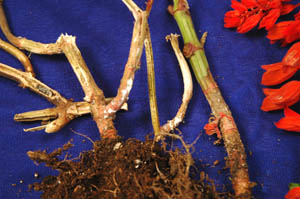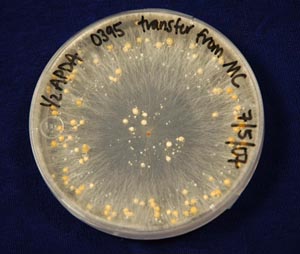Sclerotinia White Mold | |
|---|---|
| July 17, 2007 | |
|
White mold, a disease caused by the fungus Sclerotinia, is a common problem on many vegetable crops. However, this fungus infects more than 370 species of plants, including many common landscape annuals and perennials. Already this year, the Plant Clinic has confirmed white mold on a sample of Salvia splendens (bedding salvia). Other ornamentals known to be susceptible are aster, begonia, daisy, delphinium, hydrangea, marigold, pansy, peony, petunia, snapdragon, and zinnia. Often, the first symptom noticed on infected plants is wilting. Upon closer inspection, a white, fluffy mycelium can be seen on infected plants. This white growth soon (in 7 to 10 days) develops into sclerotia, fungal resting structures specialized to withstand harsh environments such as winter. The sclerotia initially are white but mature as hardened, black structures ranging in size from 1/16 to 1/2 inch.  The sclerotia can be found both on external plant parts and also inside the stem. It is these structures that germinate and cause new infections in future years, so diseased plants should be immediately removed from the garden. The sclerotia can be found both on external plant parts and also inside the stem. It is these structures that germinate and cause new infections in future years, so diseased plants should be immediately removed from the garden.Other characteristic symptoms caused by this disease are water-soaked, brown lesions on stems. The characteristic “white mold” develops only during wet weather and often disappears as the plant dries down, leaving tan (bleached-looking) lesions and stems.  Initial infections need moisture and relatively cool temperatures to occur. However, the microclimate in irrigated flowerbeds can be ideal for disease development even in dry seasons, especially if planting densities are high. There is no control once infections have occurred; remove diseased plants to reduce chances of infections in future years. The sclerotia can survive for 3 to 5 years in the soil, so consider planting nonhost species if an area was heavily infested. Report on Plant Disease, no. 1008, “Sclerotinia Disease, White Mold, or Watery Soft Rot,” provides a full list of susceptible plant species. This article can be accessed online at http://web.aces.uiuc.edu/vista/pdf_pubs/1008.pdf. It is also available in Illinois Extension offices. The presence of a white, fluffy mold and dark sclerotia are diagnostic for this disease. This growth is very white and wispy, compared to the dense gray mold of Botrytis. Southern blight, a disease caused by the fungus Sclerotium rolfsii, also produces a white mold, usually present on the base of the stem. However, the sclerotia produced by this fungus are small and tan to brown in color, greatly resembling mustard seeds.  The Plant Clinic has seen one case of southern blight this year, on a pepper crop in southern Illinois. In home landscape situations, we see S. rolfsii most frequently on hostas. This disease does not overwinter well in the north; sclerotia that are unprotected (by mulch or snow cover) generally lose their viability. (Shanyn Siegel and Nancy Pataky) The Plant Clinic has seen one case of southern blight this year, on a pepper crop in southern Illinois. In home landscape situations, we see S. rolfsii most frequently on hostas. This disease does not overwinter well in the north; sclerotia that are unprotected (by mulch or snow cover) generally lose their viability. (Shanyn Siegel and Nancy Pataky) |